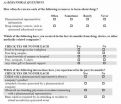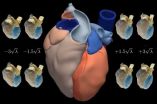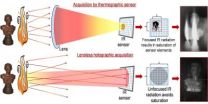(Press-News.org) In a substudy of the STAMPEDE trial (Surgical Therapy And Medications Potentially Eradicate Diabetes Efficiently), Cleveland Clinic researchers have found that gastric bypass surgery reverses diabetes by uniquely restoring pancreatic function in moderately obese patients with uncontrolled type 2 diabetes.
The two-year substudy evaluated the effects of bariatric surgery and intensive medical therapy on blood sugar levels, body composition, and pancreatic beta-cell function. Striking metabolic changes were observed in patients who underwent bariatric surgery compared with intensive medical therapy, particularly in the gastric bypass treatment group.
"The substudy results extend the findings from our initial 12-month report that showed bariatric surgery can eliminate the need for diabetes medications in many obese patients with uncontrolled diabetes," said lead investigator Sangeeta Kashyap, M.D., an endocrinologist at Cleveland Clinic's Endocrinology & Metabolism Institute. "Furthermore, we observed that gastric bypass can resurrect a failing pancreas."
The cells of the pancreas that produce insulin, a hormone that helps the body store and use sugar, are called beta cells. Malfunctioning pancreatic beta cells can cause the pancreas to not release enough insulin; they can also produce insulin that the body does not recognize. When the body can't use insulin properly, it can't regulate the amount of glucose in its bloodstream.
"Gastric bypass surgery seems to uniquely restore pancreatic beta-cell function, presumably by targeting belly fat and modifying the hormones in the gastrointestinal tract," said Kashyap. "Gastric bypass remarkably targets belly fat where hormones that are toxic to the body develop."
Researchers observed that patients who underwent gastric bypass saw a greater reduction in belly fat compared to the patients who underwent sleeve gastrectomy. The substudy results indicate a correlation between a decrease in belly fat and the ability of the pancreas to start working again.
Diabetes Care published the study results online today.
The prospective, randomized, controlled substudy followed 60 patients from the original STAMPEDE trial to determine the durability of the initial results and examine the metabolic changes observed with bariatric surgery. The patients were divided into three groups of 20: those who received intensive medical therapy of their diabetes, those who received intensive medical therapy plus gastric bypass surgery, and those who received intensive medical therapy plus sleeve gastrectomy. The researchers measured metabolic parameters at baseline, and at 12 and 24 months.
After two years, 41 percent of the patients who underwent gastric bypass saw their blood sugar levels back to normal. Only 10 percent of the patients who underwent sleeve gastrectomy and 6 percent who received intensive medical therapy achieved the same results.
At 12 and 24 months, patients who underwent gastric bypass achieved near normal blood sugar levels following a mixed meal test. These results were associated with a remarkable 5.8-fold increase in overall pancreatic cell function. Patients who received intensive medical therapy or underwent sleeve gastrectomy saw a 2-fold increase.
The substudy results show that gastric bypass surgery is a viable therapeutic option for the treatment of uncontrolled type 2 diabetes in moderately obese patients. The authors will continue to follow these patients for three years as further studies examining hormonal effects are warranted.
###
This study was funded by ADA and Ethicon Endo-Surgery, Inc., a subsidiary of Johnson & Johnson, which is a company that designs and manufactures medical devices and surgical instruments.
For more information on the STAMPEDE trial, visit clevelandclinic.org/stampede
Contacts:
Andrea Pacetti, 216.316.3040, pacetta@ccf.org
Caroline Auger, 216.636.5874, augerc@ccf.org
Cleveland Clinic study shows bariatric surgery restores pancreatic function by targeting belly fat
2-year study indicates how gastric bypass reverses diabetes
2013-02-26
ELSE PRESS RELEASES FROM THIS DATE:
Light particles illuminate the vacuum
2013-02-26
The researchers conducted a mirror experiment to show that by changing the position of the mirror in a vacuum, virtual particles can be transformed into real photons that can be experimentally observed. In a vacuum, there is energy and noise, the existence of which follows the uncertainty principle in quantum mechanics.
If we act fast enough, we can prevent the particles from recombining – they will then be transformed into real particles that can be detected', says Dr. Sorin Paraoanu from Aalto University.
For the experiment, the researchers used an array of superconducting ...
Target: Cancer
2013-02-26
For scientists to improve cancer treatments with targeted therapeutic drugs, they need to be able to see proteins prevalent in the cancer cells. This has been impossible, until now. Thanks to a new microscopy technique, University of Akron researcher Dr. Adam Smith, assistant professor of chemistry, has observed how clusters of epidermal growth factor receptor (EGFR) — a protein abundant in lung and colon cancers, glioblastoma and others — malfunctions in cancer cells.
"We can directly observe protein clusters, in a living cell membrane, that are invisible to traditional ...
Superbugs may have a soft spot, after all
2013-02-26
The overuse of antibiotics has created strains of bacteria resistant to medication, making the diseases they cause difficult to treat, or even deadly. But now a research team at the University of Rochester has identified a weakness in at least one superbug that scientists may be able to medically exploit.
Biologists Gloria Culver at Rochester and Keith Connolly, now at Harvard University, thought one key to stopping the bacteria may lie with proteins, so they studied the mechanism behind the development of bacterial ribosomes—the cell's protein-manufacturing machine. ...
Gut microbiota plays important role in functional bowel disorders
2013-02-26
(24 February 2013) An estimated 50 per cent of patients consulting a gastroenterologist suffer from functional bowel disorders (FBD), such as dyspepsia or irritable bowel syndrome (IBS). It is characteristic for these conditions that underlying physiological mechanisms are hard to be found. "However, recent research shows that the gut microbiota is a likely candidate for filling some of the gaps in the causal chain leading to FBD," says Professor Fernando Azpiroz, Chairman of the Gut Microbiota & Health Section of the European Society of Neurogastroenterology & Motility ...
Fecal microbiota transplantation cures gastrointestinal diseases
2013-02-26
(26 February 2013) Clostridium difficile infections have developed into a virtual pandemic over the past two decades. The outcome of standard antibiotic treatment is unsatisfactory: the recurrence rates are high with every relapse increasing the risk of further follow-ups. Faecal microbiota transplantation offers a rapidly acting and highly effective alternative in treating recurrent Clostridium difficile infections (RCDI), as Professor Lawrence J. Brandt (Montefiore Medical Center, New York, USA) points out. According to him, more than 90 per cent of the patients are being ...
Survey shows medical students have frequent interactions with pharmaceutical companies
2013-02-26
Boston – A first-of-its kind national survey of medical students and residents finds that despite recent efforts by medical schools and academic medical centers to restrict access of pharmaceutical sales representatives to medical trainees, medical students and residents still commonly receive meals, gifts, and industry-sponsored educational materials. The study was completed by a team of researchers led by fourth-year Harvard Medical School student Kirsten Austad and Aaron Kesselheim, M.D., J.D., M.P.H., an internist and health policy researcher in the Division of Pharmacoepidemiology ...
An atlas of the human heart is drawn using statistics
2013-02-26
Researchers at Pompeu Fabra University (Spain) have created a high resolution atlas of the heart with 3D images taken from 138 people. The study demonstrates that an average image of an organ along with its variations can be obtained for the purposes of comparing individual cases and differentiating healthy forms from pathologies.
"This atlas is a statistical description of how the heart and its components – such as the ventricles and the atrium – look," as explained to SINC by Corné Hoogendoorn, researcher at the CISTIB centre of the Pompeu Fabra University.
Scientists ...
Infrared digital holography allows firefighters to see through flames, image moving people
2013-02-26
Firefighters put their lives on the line in some of the most dangerous conditions on Earth. One of their greatest challenges, however, is seeing through thick veils of smoke and walls of flame to find people in need of rescue. A team of Italian researchers has developed a new imaging technique that uses infrared (IR) digital holography to peer through chaotic conflagrations and capture potentially lifesaving and otherwise hidden details. The team describes its breakthrough results and their applications in a paper published today in the Optical Society's (OSA) open-access ...
Sweet news for stem cell's 'Holy Grail'
2013-02-26
Scientists have used sugar-coated scaffolding to move a step closer to the routine use of stem cells in the clinic and unlock their huge potential to cure diseases from Alzheimer's to diabetes.
Stem cells have the unique ability to turn into any type of human cell, opening up all sorts of therapeutic possibilities for some of the world's incurable diseases and conditions.
The problem facing scientists is how to encourage stem cells to turn into the particular type of cell required to treat a specific disease.
But researchers at the University of Manchester's School ...
A picture of health in schools
2013-02-26
Feeling comfortable and confident in sport, health, or PE can be very difficult for some young people who can be seen as a 'risk' of becoming obese. Young people from ethnic minorities, especially girls, are more likely to be physically inactive and unhealthy.
This perception needs to be addressed and challenged in school physical education (PE) according to research funded by the Economic and Social Research Council (ESRC), which shows how school provision could make use of visual approaches in developing young people's critical learning about the body.
When Dr Laura ...
LAST 30 PRESS RELEASES:
New expert guidance urges caution before surgery for patients with treatment-resistant constipation
Solar hydrogen can now be produced efficiently without the scarce metal platinum
Sleeping in on weekends may help boost teens’ mental health
Study: Teens use cellphones for an hour a day at school
After more than two years of war, Palestinian children are hungry, denied education and “like the living dead”
The untold story of life with Prader-Willi syndrome - according to the siblings who live it
How the parasite that ‘gave up sex’ found more hosts – and why its victory won’t last
When is it time to jump? The boiling frog problem of AI use in physics education
Twitter data reveals partisan divide in understanding why pollen season's getting worse
AI is quick but risky for updating old software
Revolutionizing biosecurity: new multi-omics framework to transform invasive species management
From ancient herb to modern medicine: new review unveils the multi-targeted healing potential of Borago officinalis
Building a global scientific community: Biological Diversity Journal announces dual recruitment of Editorial Board and Youth Editorial Board members
Microbes that break down antibiotics help protect ecosystems under drug pollution
Smart biochar that remembers pollutants offers a new way to clean water and recycle biomass
Rice genes matter more than domestication in shaping plant microbiomes
Ticking time bomb: Some farmers report as many as 70 tick encounters over a 6-month period
Turning garden and crop waste into plastics
Scientists discover ‘platypus galaxies’ in the early universe
Seeing thyroid cancer in a new light: when AI meets label-free imaging in the operating room
Neutrophil-to-lymphocyte ratio may aid risk stratification in depressive disorder
2026 Seismological Society of America Annual Meeting
AI-powered ECG analysis offers promising path for early detection of chronic obstructive pulmonary disease, says Mount Sinai researchers
GIMM uncovers flaws in lab-grown heart cells and paves the way for improved treatments
Cracking the evolutionary code of sleep
Medications could help the aging brain cope with surgery, memory impairment
Back pain linked to worse sleep years later in men over 65, according to study
CDC urges ‘shared decision-making’ on some childhood vaccines; many unclear about what that means
New research finds that an ‘equal treatment’ approach to economic opportunity advertising can backfire
Researchers create shape-shifting, self-navigating microparticles
[Press-News.org] Cleveland Clinic study shows bariatric surgery restores pancreatic function by targeting belly fat2-year study indicates how gastric bypass reverses diabetes



